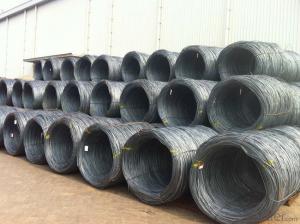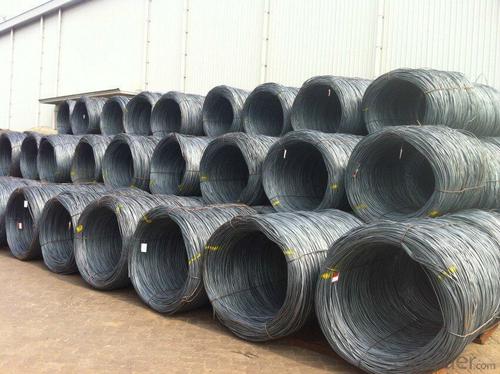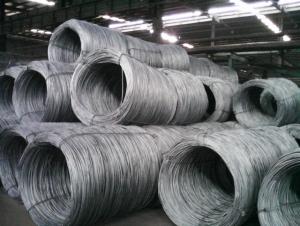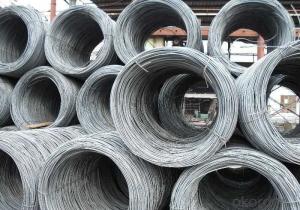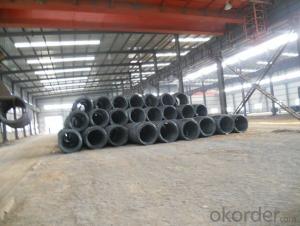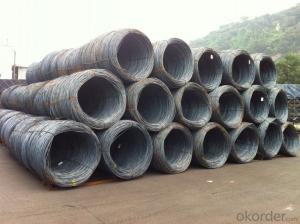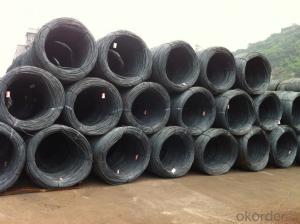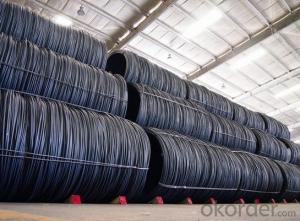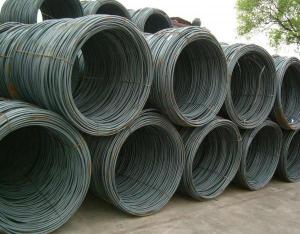Supply Low Carbon Steel Wire Rod for Contruction
- Loading Port:
- Tianjin
- Payment Terms:
- TT OR LC
- Min Order Qty:
- 25 m.t.
- Supply Capability:
- 5000 m.t./month
OKorder Service Pledge
OKorder Financial Service
You Might Also Like
Specification
Specifications of Steel Wire Rod in Coil:
Steel Grade: Q195/235, SAE1006-1018B Standard: ASTM, GB
Diameter: 5.5mm, 6.5mm, 7mm,8mm,9mm,10mm,12mm,14mm
Type: Drawn Wire Alloy or Not: Alloy Brand Name: HSKY
Technique: Hot Rolled Place of Origin: China Mainland
Chemical Composition:(Please kindly find our chemistry of our material based on SAE1006B and SAE1008B as below for your information)
High carbon/Low carbon/common carbon Steel wire rod | With boron for rebate tax |
Grade | SAE1006B SAE1008B SAE1018B |
Package | In coil ,in bundle, |
Coil weight | about 2000kg-3000kgs |
Size: | 5.5mm 6.5mm 8mm 10mm 12mm 14mm 16mm |
Types | High Carbon ,Low carbon ,Common carbon |
Exported Country | South Korea,Vietnam,Indonesia,Myanmar,Philippines and Afrca,Ect |
Delivery term: | within 30 days after receive the LC |
Payment Term: | LC at sight ,LC 30-120 days after B/L date, TT payment |
The Standard of Physical Properties:
Grade | Chemical Composition(%) | |||||
C | Mn | Si | S | P | Cr | |
SAE1006 | 0.03~O.07 | ≤0.32 | ≤0.30 | ≤0.045 | ≤0.040 | >0.30 |
Mechanical properties | ||||||
Yield strength(N/mm2) | Tensile strength(N/mm2) | Elongation(%) | ||||
250-280 | 350-380 | ≥32 | ||||
Grade | Chemical Composition(%) | |||||
C | Mn | Si | S | P | Cr | |
SAE1008 | 0.10max | 0.3~O.50 | 0.15max | 0.050max | 0.040 max | 0.30 min |
Mechanical properties | ||||||
Yield strength(N/mm2) | Tensile strength(N/mm2) | Elongation(%) | ||||
≥195 | 315-430 | ≥30 | ||||
Usage and Applications of Steel Wire Rod in Coil:
After hot-rolled the products shaped into coil and delivery as finished product, including round, square, rectangular, hexagonal and so on, Since most of the products are round, it is generally called wire rod. Steel wire rod is widely used in construction and manufacturing. Steel wire rod is mainly used for reinforcement of reinforced concrete and welded structure or reprocessed (roberts, nail etc) materials, especially used to produce wire drawing, welding electrode, nails,spring, electronic, precise machinery parts and so on.
Packaging & Delivery of Steel Wire Rod in Coil:
Packaging Detail: products are packed in coil and then shipped by container or bulk vessel
Each coil weight: 2-3MT
Delivery Detail: within 45 days after received deposit or LC.
Label: to be specified by customer, generally, each bundle has 1-2 labels
Trade terms: CFR, CIF
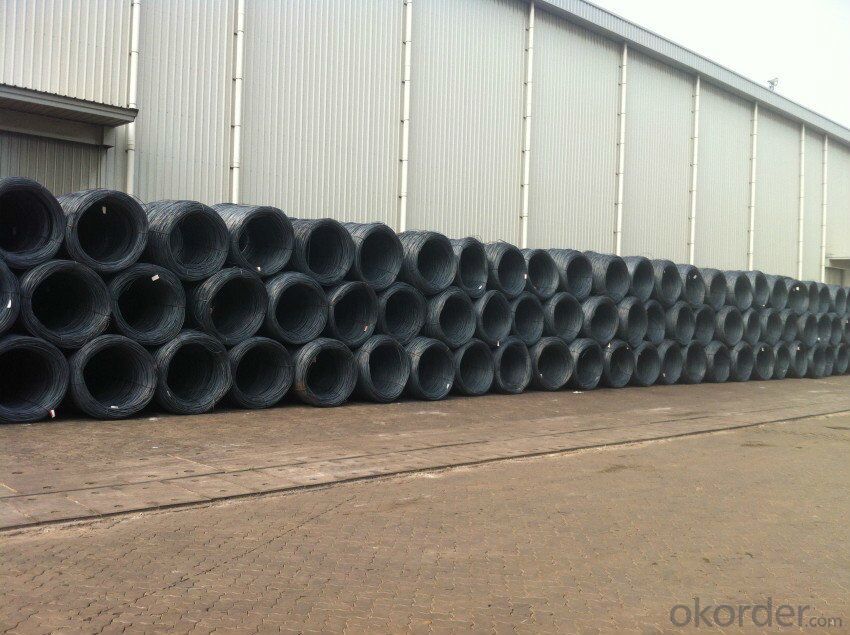
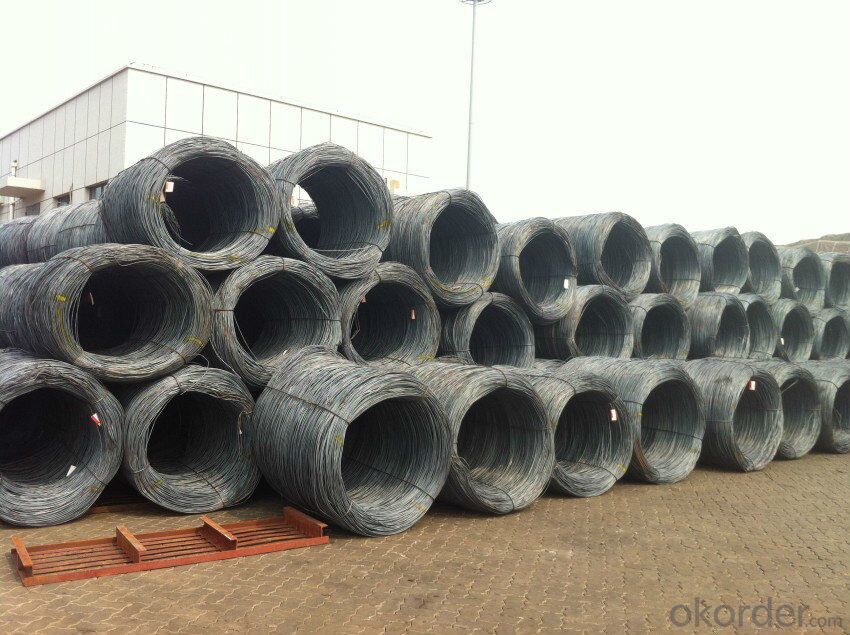
- Q: What are the common production processes for actinium-coated steel wire rod?
- The common production processes for actinium-coated steel wire rod include wire drawing, cleaning and surface preparation, actinium coating, drying, and final quality inspection.
- Q: What are the common production processes for xenon-coated steel wire rod?
- The common production processes for xenon-coated steel wire rod typically involve cleaning and pre-treating the steel wire rod, followed by applying a xenon coating using various methods such as physical vapor deposition or chemical vapor deposition. The coated wire rod is then subjected to curing or annealing processes to enhance the adhesion and durability of the xenon coating. Finally, the wire rod is further processed into desired shapes or sizes for specific applications.
- Q: What are the different types of steel wire rod defects that can occur during wire drawing?
- During the wire drawing process, various steel wire rod defects can arise, impacting the final wire product's quality and performance. Notable defects include: 1. Surface cracks, caused by improper cooling or excessive rolling pressure, visibly weaken the wire, resulting in premature failure. 2. Internal cracks, which are not visible to the naked eye, compromise the wire's strength and ductility due to incorrect heating or cooling during manufacturing. 3. Scale, the oxide layer forming on the wire rod's surface, can lead to surface defects and reduce the wire's corrosion resistance if excessive. 4. Decarburization occurs when excessive heating or prolonged exposure to high temperatures reduces the wire rod's carbon content, weakening it and affecting its mechanical properties. 5. Segregation refers to the non-uniform distribution of alloying elements within the wire rod, causing inconsistent mechanical properties and impacting the wire's performance. 6. Surface defects, including scratches, pits, or indentations, arise from improper handling or inadequate equipment maintenance. 7. Overlaps occur when the wire rod is improperly aligned during the wire drawing process, resulting in uneven thickness or irregular cross-sections in the final wire product. 8. Surface contamination arises from contaminants like dirt, oil, or rust adhering to the wire rod during production or storage, leading to reduced adhesion, poor surface finish, or corrosion problems. To ensure the production of high-quality wire products meeting desired specifications and performance requirements, it is crucial to identify and address these defects throughout the wire drawing process.
- Q: How is steel wire rod used in the manufacturing of wire forms for packaging?
- Steel wire rod is an essential material used in the manufacturing of wire forms for packaging. It serves as the base material for creating various wire products that are widely used in packaging applications. One of the primary uses of steel wire rod in packaging is the production of wire baskets and racks. These wire forms are commonly used for storing and transporting goods, providing a sturdy and reliable solution for packaging needs. The steel wire rod is processed and shaped into different forms and sizes to create these wire baskets and racks, which are then used for organizing and protecting various packaged items. Additionally, steel wire rod is also utilized in the production of wire hooks and clips. These wire forms are often used to secure packaging materials, such as plastic bags or boxes, preventing them from opening or spilling their contents during transportation. The durability and strength of steel wire rod make it an ideal material for creating these hooks and clips, ensuring that packaging remains intact and secure. Moreover, steel wire rod is employed in the manufacturing of wire ties, also known as twist ties or bag closures. These wire forms are commonly used in the packaging industry to seal bags, bundles, or packages, providing a simple yet effective way to keep items tightly sealed and protected. The flexibility and malleability of steel wire rod allow for easy bending and shaping into twist ties, making it an essential component in their production. Overall, steel wire rod plays a crucial role in the manufacturing of wire forms for packaging. Its strength, durability, and versatility make it a preferred material for creating various wire products used in packaging applications, such as baskets, racks, hooks, clips, and twist ties. By utilizing steel wire rod, packaging solutions can be designed to withstand the rigors of transportation and ensure the safe and secure handling of goods.
- Q: How is steel wire rod used in the manufacturing of wire for overhead power lines?
- Steel wire rod is an essential component in the production of wire used for overhead power lines. It acts as the primary raw material in the manufacturing process. The initial step involves melting steel scrap or iron ore in a furnace to create molten steel. This molten steel is then continuously cast into billets or blooms, which are large rectangular or round bars. The subsequent step entails rolling these billets or blooms into steel wire rod. This procedure typically occurs in a wire rod mill, where the billets or blooms are heated and passed through a series of rollers that gradually reduce their size and shape them into long, thin rods. Usually, the steel wire rods are hot-rolled, meaning they are formed while the steel is still at a high temperature. The hot-rolling process grants the wire rod its desired strength and flexibility, making it suitable for use in overhead power lines. Once the steel wire rod is manufactured, it undergoes further processing to convert it into wire for overhead power lines. This involves a sequence of drawing operations, wherein the wire rod is pulled through a series of dies to gradually diminish its diameter and increase its length. This drawing process guarantees that the wire attains the necessary dimensions and mechanical properties. After the wire has been drawn to the desired specifications, it usually undergoes heat treatment to enhance its strength and durability. This heat treatment process, referred to as annealing, involves heating the wire to a specific temperature and then gradually cooling it to alleviate internal stresses and enhance its metallurgical properties. Finally, the wire is coated with a protective material, such as zinc, to prevent corrosion and prolong its lifespan. This coating process, known as galvanization, entails immersing the wire in a molten zinc bath or utilizing an electroplating method to apply a zinc layer onto its surface. Overall, steel wire rod plays a crucial role in the production of wire for overhead power lines. It provides the necessary raw material for the manufacturing process and undergoes various stages of rolling, drawing, heat treatment, and coating to transform into a high-quality wire capable of withstanding the demanding conditions of power transmission.
- Q: What are the environmental benefits of recycling steel wire rod?
- Recycling steel wire rod provides various benefits to the environment. The foremost advantage is the conservation of natural resources. By recycling steel, we can decrease the necessity for extracting and mining iron ore, which is the primary raw material utilized in steel production. This lessens the environmental impact of mining activities, which encompass deforestation, habitat destruction, and soil erosion. Moreover, recycling steel wire rod aids in reducing energy consumption and greenhouse gas emissions. The production of steel from recycled materials requires considerably less energy compared to the production from virgin materials. Additionally, the recycling process emits fewer greenhouse gases, such as carbon dioxide, in comparison to manufacturing steel from scratch. By recycling steel wire rod, we can help mitigate climate change and diminish our carbon footprint. Furthermore, recycling steel wire rod assists in waste reduction and conserves landfill space. Steel is a long-lasting material that can be recycled indefinitely without losing its properties. By recycling steel wire rod, we can divert this material from ending up in landfills, where it would occupy valuable space and contribute to pollution. Additionally, recycling steel wire rod diminishes the necessity for new steel production, which can result in waste generation and environmental pollution during the manufacturing process. Lastly, recycling steel wire rod aids in safeguarding ecosystems and wildlife. Mining activities for iron ore extraction can have devastating effects on ecosystems, including forest destruction, water source contamination, and disruption of wildlife habitats. By reducing the demand for new steel production through recycling, we can minimize the negative impacts on ecosystems and preserve biodiversity. In conclusion, recycling steel wire rod presents numerous environmental benefits, such as the conservation of natural resources, reduction in energy consumption and greenhouse gas emissions, waste reduction, and protection of ecosystems and wildlife. By opting to recycle steel wire rod, we can contribute to a more sustainable and eco-friendly future.
- Q: How is steel wire rod used in the production of electrical conductors?
- The production of electrical conductors heavily relies on steel wire rod, which is a crucial component. This raw material is utilized to manufacture various types of wire and cables that are indispensable for the transmission and distribution of electricity. To initiate the process, the steel wire rod is drawn through a series of dies. This action reduces its diameter and increases its length. As a result, the wire is not only strengthened but also improves its electrical conductivity. Subsequently, the wire goes through further processing to meet specific requirements for electrical conductors. The utilization of steel wire rod extends to the production of power cables, which are responsible for transmitting electricity across long distances. These cables consist of multiple layers, including a conductor made from steel wire rod. The conductor serves as a pathway for the electrical current to flow, facilitating the transmission of power from power plants to different locations. Apart from power cables, steel wire rod is also employed in the manufacturing of electrical wires and cords. These wires are utilized in residential, commercial, and industrial applications to connect electrical devices and appliances to power sources. The selection of steel wire rod is based on its high tensile strength and durability, ensuring that the wires can endure the demands of daily usage. Furthermore, steel wire rod is a crucial component in the production of overhead transmission lines. These lines are vital for the distribution of electricity from substations to local power grids. The conductive strands within these transmission lines are created using steel wire rod, which enables efficient and reliable power distribution. In conclusion, steel wire rod plays a pivotal role in the production of electrical conductors. Its strength, conductivity, and versatility make it an ideal material for manufacturing power cables, electrical wires, and transmission lines. Without steel wire rod, the efficient transmission and distribution of electricity would be unattainable.
- Q: Can steel wire rod be used in the production of wire mesh?
- Yes, steel wire rod can be used in the production of wire mesh. Steel wire rod is a raw material that is commonly used to manufacture various types of wire products, including wire mesh. Wire mesh is made by weaving or welding steel wires together to create a grid-like pattern. The steel wire rod is often drawn through a series of dies to reduce its diameter and increase its strength before being used to create the wire mesh. The resulting wire mesh is commonly used in a variety of applications such as fencing, construction, agriculture, and industrial settings.
- Q: What are the common packaging materials used for steel wire rod coils?
- The common packaging materials used for steel wire rod coils are wooden pallets, steel straps, and plastic wrapping.
- Q: How is steel wire rod used in the manufacturing of wire for electrical grounding systems?
- Steel wire rod is an essential component in the manufacturing of wire for electrical grounding systems. These systems play a crucial role in ensuring the safety and functionality of electrical installations by providing a path for electrical currents to flow into the ground, thus preventing damage or electrical shocks. In the manufacturing process, steel wire rods are first subjected to a series of shaping and forming operations. The wire rods are typically drawn through a series of dies to reduce their diameter and achieve the desired thickness. This drawing process helps in strengthening the wire and ensuring uniformity in its dimensions. The steel wire rods used for electrical grounding systems are generally made of high-quality carbon or stainless steel to ensure durability and resistance to corrosion. Once the steel wire rods have been drawn into the desired wire size, they are then subjected to various surface treatments. These treatments can include galvanization, which involves coating the wire with a layer of zinc to enhance its corrosion resistance. Galvanization also improves the electrical conductivity of the wire, making it more efficient for grounding purposes. After the surface treatment, the wire is then cut into specific lengths and spooled onto reels or coils. These wire coils are then used in the manufacturing of electrical grounding systems, such as grounding cables, conductors, or earth electrodes. The steel wire serves as the core component, providing strength and stability to the grounding system. The wire manufactured from steel wire rod is highly versatile and can be used in various electrical grounding applications, ranging from residential and commercial buildings to industrial facilities. It is commonly used for grounding electrical equipment, machinery, and infrastructure, ensuring the safe dissipation of electrical currents. In summary, steel wire rod is a fundamental material in the production of wire for electrical grounding systems. Its strength, durability, and resistance to corrosion make it an ideal choice for ensuring the safety and functionality of electrical installations.
Send your message to us
Supply Low Carbon Steel Wire Rod for Contruction
- Loading Port:
- Tianjin
- Payment Terms:
- TT OR LC
- Min Order Qty:
- 25 m.t.
- Supply Capability:
- 5000 m.t./month
OKorder Service Pledge
OKorder Financial Service
Similar products
Hot products
Hot Searches
Related keywords
